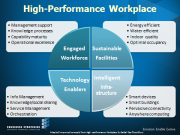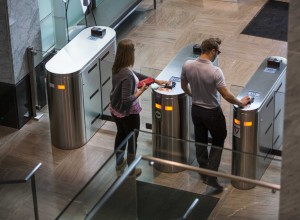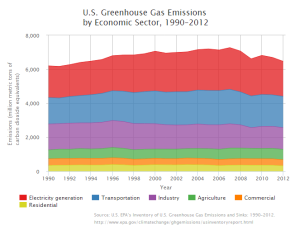The “Internet of Things” – Most of Us Have Office Space in Buildings Owned by Others

One thrust governments have historically undertaken, and will continue to, is seeding innovation “societally.” Medicine and health care immediately come to mind. So do: Transportation; Agriculture; and, Green House Gas Emissions (GHGs) Reduction. (Solyndra also occurs.)
Today’s post is about refined strategies and some of the latest features of “smart buildings,” and what, as per a Washington Post article writer, systems technologists call the “Internet of Things.”
In addition to the usual energy saving strategies of harvesting daylight by offering larger, insulated windows and exterior or interior “light shelves,” the article calls attention to monitoring corridor/hallway use and even mechanical system “hindrances.”
With the use of monitoring sensors, a hallway found by actual traffic pattern to be lesser utilized over some time period can have its cooling and heating capacity, as well as lighting, reduced in order to save energy.
More interesting, you might find, is the need to reserve your desk online so that you’ll be able to turn on the lights and plugs when you arrive. Heh, if you forget, you’ll have to use  an electronic kiosk in the lobby; and there might be a queue. If you’ve remembered, your card swipe in the lobby ID scanner will activate the power source at the reserved desk and actually turn on the lights and plugs after you sit down.
an electronic kiosk in the lobby; and there might be a queue. If you’ve remembered, your card swipe in the lobby ID scanner will activate the power source at the reserved desk and actually turn on the lights and plugs after you sit down.
And, if your desk use goes beyond the time reserved, guess what happens? (Right!) Same applies if you’re using a reserved conference room. Of course this new technology calls for new things-to-remember; and, the occasional glitch to cope with.
The GSA is leading in this arena of innovation for the reduction of waste in commercial office buildings it owns or leases. For more about the “Internet of Things,” click here.
Remember, electricity/buildings are responsible for nearly 40% of total U.S. carbon footprint. (Transportation isn’t that far behind at better than 30%.) According to the U. S. Green Building Council: “U.S. buildings alone are responsible for more CO2 emissions annually than those of any other country except China. Most of these emissions come from the combustion of fossil fuels to provide heating, cooling and lighting, and to power appliances and electrical equipment.”
- In 2012, U.S. GHGs totaled more than 6.5 mil. metric tons of CO2 equivalents (source: U.S. EPA. Climate Change web page)
- U.S. emissions decreased by 3.4% from 2011 to 2012. Recent trends, according to the EPA, can be attributed to multiple factors including: reduced emissions from electricity generation; improvements in fuel efficiency in vehicles with reductions in miles traveled; and, year-over-year changes in the prevailing weather.
- GHS in 2012 were 10% below 2005 levels. (Breathing easier on that news.)
Last month the World Congress of International Union of Architects, representing 1.3 million architects in 124 countries worldwide, signed a declaration to phase out CO2 emissions in buildings by 2050, called the 2050 Imperative. Another of the signatories was ICOMOS (International Council of Monuments and Sites), a non-governmental organization dedicated to the conservation of the most historic monuments and sites around the globe which are physically threatened by GHGs aka air pollution.
 Incidentally, here’s a leading-edge company that’s already achieved net zero emissions in its global ops. Learn how they did it.
Incidentally, here’s a leading-edge company that’s already achieved net zero emissions in its global ops. Learn how they did it.
Post Script–
 An interesting project for school-age kids might be to measure a building’s carbon footprint. Here’s a how-to resource.
An interesting project for school-age kids might be to measure a building’s carbon footprint. Here’s a how-to resource.

